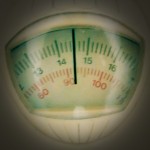 The association between exercise and body weight is fairly well established in the nutritional literature. Generally those who perform more physical activity have lower body weights. However, the cause and effect of this association are far from clear, with indications suggesting that exercise does not cause weight loss in the overweight or those with metabolic syndrome (here). Therefore some other mechanisms must explain the relationship, and confounding variables must be considered. Because abdominal obesity is known to be a disease characterised by metabolic dysfunction that causes aberrations in energy production, it is likely that the obesity is the causal factor in the association between exercise and body weight. The metabolic syndrome is characterised by liver damage (here) and this reduces the efficiency of the rate of oxidation of fuels through mitochondrial dysfunction. Energy is therefore effectively sequestered away in adipose tissue, and prevented from fuelling activity through tight hormonal control.
The association between exercise and body weight is fairly well established in the nutritional literature. Generally those who perform more physical activity have lower body weights. However, the cause and effect of this association are far from clear, with indications suggesting that exercise does not cause weight loss in the overweight or those with metabolic syndrome (here). Therefore some other mechanisms must explain the relationship, and confounding variables must be considered. Because abdominal obesity is known to be a disease characterised by metabolic dysfunction that causes aberrations in energy production, it is likely that the obesity is the causal factor in the association between exercise and body weight. The metabolic syndrome is characterised by liver damage (here) and this reduces the efficiency of the rate of oxidation of fuels through mitochondrial dysfunction. Energy is therefore effectively sequestered away in adipose tissue, and prevented from fuelling activity through tight hormonal control.
As well as the sequestration of available energy, obesity is characterised by other metabolic dysfunctions that make the generation of energy more inefficient. For example, erythropoiesis may be impaired in the obese, thus inhibiting efficient generation of aerobic energy. In a study published in the International Journal of Obesity, researchers investigated the reasons for the increased risk of iron deficiency in obese children compared to normal weight children1. This was done by measuring the dietary iron intake and iron status of overweight and normal weight children between the ages of 6 and 14 years. The researchers found no significant differences between the iron intakes of the children, or in the ability to absorb that iron. However, the incidence of iron deficient erythropoiesis was higher in the overweight children, compared to the normal weight children. When the authors measured the serum hepcidin, a hormone that inhibits iron absorption across the gut, they found levels significantly elevated in the obese children.
The authors also investigated associations between the serum hepcidin concentrations of the children and their degree of obesity. This analysis showed that serum hepcidin was correlated with the degree of obesity as measured by body mass index. Iron deficient erythropoiesis is the second clinical stage of iron deficient anaemia, characterised by an increased concentration of serum transferrin, which is raised in an effort to increase iron uptake into erythrocyte producing cells. For example, in the same study, serum transferrin receptor concentrations were elevated in the obese children. Other studies have also reported poor iron status in the obese. In a study published in the American Journal of Clinical Nutrition, researchers showed that obese subjects had lower mean serum iron values when compared to non-obese subjects. In addition, more of the obese subjects fell into the ‘low iron status’ category than the non-obese subjects2. Therefore obesity is characterised by dysfunctional metabolism of iron and erythrocyte production.
If obesity and abdominal fat are associated with metabolic dysfunction in iron regulation, this could explain some or all of the association between exercise and body weight. This suggest that the obese may not exercise so much because they cannot physically generate enough energy. Take someone with iron deficiency anaemia, for example. This person would find physical activity incredibly hard because their body would not be able to generate enough aerobic energy. Because iron is required for haemoglobin and myoglobin formation, iron deficient anemia significantly reduces the oxygen carrying capacity of the blood and skeletal muscles and reduces the production of aerobic energy. To call such individuals lazy would be completely unjustified. And yet that is what many claim of the obese. In addition forcing exercise upon those those with poor iron status would not benefit their ‘laziness’ and would not be expected to cause weight loss. In fact the detrimental effects of the stress of exercise may outway any perceived benefits.
Once metabolic dysfunctions have developed in the overweight they are not reversible through exercise regimens or energy restriction. Applying stress to the body in the form of physical activity does not reverse obesity just as forcing an unwell person to exercise does not reverse their illness. Poor quality food, including refined carbohydrates and fructose are the cause of the obesity, and until they are removed from the diet and replaced with whole grains and healthier alternatives, no amount of physical activity will lead to weight loss. Early studies that investigated energy restriction and forced exercise regimens using prisoners and military personnel were complete failures because they caused serious illness in the subjects. Application of similar stress to obese individuals with metabolic dysfunctions makes no sense and is destined to end in failure. It is my contention that reversal of metabolic dysfunctions with high quality nutrition will return normal work output efficiency which will subsequently allow increase physical activity in the obese.
